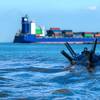Northrop Grumman Corporation's Ship Systems sector has successfully tested the Low Observable Multifunction Stack (LMS) designed to demonstrate two different advanced exhaust suppresser systems for surface combatants.
The exhaust systems, enclosed in a low signature composite structure, also integrate embedded multifunction communication arrays. The combination of these different technologies into a single, integrated low observable composite structure is advancing the military effectiveness of future surface combatants, according to Richard Schenk, president of Ship Systems' Full
Service Center.
"This integrated approach will help provide increased connectivity necessary for modern warfare while avoiding the mass of communications
antennas that typically cover the topside of surface combatants," said Schenk.
The project was sponsored by the Office of Naval Research through its Advanced Technology Demonstration (ATD) program. Northrop Grumman Ship Systems has been an active participant and ship system integrator on every ATD program related to Topside Integration. Execution management of the project is provided jointly by the Naval Sea Systems Command and the Space and Naval Warfare Command (SPAWAR).
"The success of the LMS ATD could not have been achieved without the excellent cooperation between the Navy and Northrop Grumman, and specifically without the efforts of Ron Wilson, the Northrop Grumman program manager, and
his team of engineers and craftsmen," noted Bill Bird, Navy technical manager
from the Naval Surface Warfare Center, Carderock Division (NSWCCD).
Construction of the LMS was completed at the Northrop Grumman Ship Systems Avondale Operations composite facility in Gulfport, Miss., in July 2001.
After completing construction, the LMS structure was barged to Ship Systems' Ingalls Operations' East Bank facility in Pascagoula, Miss., for final
fit-out, and land-based testing of its Radar Cross Section (RCS).
The RCS testing was performed at the Ship Systems Near Field Radar Reflectivity Range (NFR3) facility. The newly constructed NFR3 facility provides the capability to measure the radar reflectivity of large structures
accurately and with high resolution. The LMS RCS testing was conducted over a two-week period with radar instrumentation provided by NSWCCD.
"The NFR3 facility was instrumental in demonstrating the performance of
the LMS and greatly reduced the potential cost of testing at other East or West Coast facilities," stated Ross Buck, engineering project manager and Ship Systems Radar Range Test director.
After RCS testing, the LMS structure was installed on an Ex-Asheville
class patrol gunboat for additional testing at-sea near Panama City, Fla. The additional tests included at-sea signature measurements of the LMS and tests of the communication capabilities of the antenna systems embedded within the
LMS structure.
"The LMS project team is to be commended for advancing the state of the
art and building a strong foundation for future Topside Technology," said Mr.
Bird. The team includes U.S. Navy participants from the Naval Warfare
Centers, the Naval Postgraduate School and SPAWAR along with industrial
partners Ball Aerospace and Communications, Boeing Aerospace and Northrop
Grumman Ship Systems.
Sponsored Content
Chris-Marine’s solutions help to prolong engine lifetime

March 2024
 Read the Magazine
Read the Magazine

 Read the Magazine
Read the Magazine
This issue sponsored by:

New Orleans is Sinking, and it is Not Tragically Hip
Subscribe for
Maritime Reporter E-News
Maritime Reporter E-News is the maritime industry's largest circulation and most authoritative ENews Service, delivered to your Email five times per week










